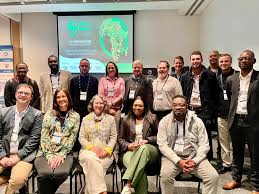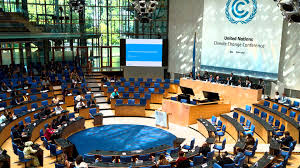- The Director, USTDA, Enoh Ebong, signs agreement with the hospitals’ CEOs for the disbursement of the grants at the U.S Embassy, Abuja, on Monday.
The United States Trade and Development Agency (USTDA) has awarded three million dollars grant to three private hospitals in Nigeria for the improvement of healthcare delivery.
The Director, USTDA, Enoh Ebong, who announced this at the U.S. Embassy, Abuja, on Monday, said that over 25 thousand Nigerians would benefit from the project.
She listed the benefiting hospitals as: Lily Hospitals Ltd., Cedarcrest Hospital, and Mobihealthcare Limited (Mobihealth)
Ebong explained that the aim of the project was to provide access to good healthcare to Nigerians by partnering healthcare providers.
According to her, the project entails leveraging financing with reasonable investment in grants that will unlock millions of doors financing to implement it.
The grant to Lily Hospitals Limited is for a feasibility study to support the refurbishment and operation of 10 healthcare facilities in Nigeria.
These facilities, located in multiple urban hubs across the country, will serve up to 25,000 patients annually.
She said that Lily selected Maryland-based Anadach Consulting Group, LLC, to conduct the study.
Ebong lauded Lily hospitals for resuscitating hospitals, which were in bad conditions and making them good again for the benefit of Nigerians.
She said, “Promoting access to quality healthcare services is a top priority for USTDA in Nigeria.
“Our partnership with Lily will provide the company with the necessary analysis to make informed decisions in support of its healthcare delivery priorities.
“At the same time, USTDA’s engagement will help create opportunities for U.S. companies to supply the technologies and services that these healthcare facilities will require.”
According to her, the USTDA’s study will assess and recommend the most suitable healthcare facilities for Lily to refurbish and integrate into its existing network of facilities.
The director said that the project would also increase access to modern, quality healthcare systems at a lower cost and in a shorter timeframe than commissioning and constructing new healthcare facilities.
Speaking at the event, Dr. Austin Okogun, the CEO of Lily Hospitals,said that the USTDA grant was very timely, adding that it supported Lily’s expansion strategy of reactivating underperforming healthcare facilities.
“This will revitalise neighborhoods, create employment opportunities, support investment, and contribute to economic growth.
“This project will allow more healthcare professionals to contribute to their communities, while offering partnerships and franchise opportunities to medical and related clinical experts.
“It will also offer opportunities for U.S. companies to supply the high-quality technologies that these facilities will require. Above all else, we are committed to improving access to good quality and affordable care to Nigerians.”
The grant to Cedarcrest Hospitals is for a feasibility study to develop a comprehensive cancer treatment centre in Abuja that will provide diagnosis and treatment services for up to 1,000 patients per centre.
Ebong said, “In respect to Cedarcrest Hospital, they saw a need in cancer treatment, prescriptions and the whole range of services required.
“So we will be providing them with the grants to improve their services.
“The goal of USTDA’s assistance is to save lives using innovative healthcare technologies.
“I believe U.S. companies will be eager to partner with Cedarcrest to help expand access to world-class cancer care in Nigeria.”
In his remark, Dr. Felix Ogedengbe, Cedarcrest’s CEO, said the hospital was very delighted to be a recipient of the grant from USTDA.
“As a private multispecialty hospital group, we have been at the forefront of ensuring the availability of highly specialized healthcare locally and have recently decided to expand into the oncology treatment space.
“This grant will no doubt aid in achieving the dream of setting up a comprehensive cancer diagnosis and treatment centre, make these services available locally, and ensure in-bound medical tourism from the subregion.
“In making this grant, USTDA has shown its commitment to helping develop highly skilled local capacity in cancer treatment,” Ogedengbe added.
Ebong further explained that the grant to Mobihealth was for a feasibility study to support the expansion of its telehealth services from Nigeria to Côte d’Ivoire, Ghana, Kenya, and Egypt.
The director added that it was a collaborative effort to expand healthcare access for 100,000 individuals per year across Africa.
She said that the Africa Investment Forum (AIF) was collaborating with USTDA to facilitate the development and financing of Mobihealth’s project.
Ebong said, “By partnering with Mobihealth, our goal is to transform the delivery of healthcare to underserved communities across Africa using the best technology that U.S. industry has to offer.
“It is also gratifying to see women-led businesses such as Mobihealth leading the development of critical infrastructure on the continent.”
Also speaking, Mobihealth CEO, Funmi Adewara, said: “The USTDA grant comes at an opportune time and will enable us to expand the scope of our integrated telehealth, electronic medical records, and digitalisation services to several other African markets over the next few years.
“African female entrepreneurs find it much harder to raise funds, so this support from the USTDA, made possible through the AIF, will be invaluable. The impact this project will have across Africa’s healthcare system cannot be over emphasized.”
The News Agency of Nigeria (NAN) reports that the USATD grants is one of the key pillars of the Biden Administration’s Partnership for Global Infrastructure and Investment.
The project aims to strengthen global health security through investments in patient-centered health services.
It also advances the U.S. government’s Prosper Africa initiative to substantially increase two-way trade and investment between the United States and Africa.
Source: NAN








jenniferroy フェチポルノ japanesexxporns.hNP2zvPiQzS
The next time I read a blog, I hope that it doesnt disappoint me as much as this one. I mean, I know it was my choice to read, but I actually thought youd have something interesting to say. All I hear is a bunch of whining about something that you could fix if you werent too busy looking for attention.
I don’t think the title of your article matches the content lol. Just kidding, mainly because I had some doubts after reading the article.
Can you be more specific about the content of your article? After reading it, I still have some doubts. Hope you can help me.
good article please join my site bro yaa ..
Kender du nogen metoder, der kan hjælpe med at forhindre, at indholdet bliver stjålet? Det ville jeg sætte stor pris på.
I think this site holds very great pent articles articles.
Thanks for sharing. I read many of your blog posts, cool, your blog is very good.
Hello, I think your site might be having browser compatibility issues. When I look at your blog in Opera, it looks fine but when opening in Internet Explorer, it has some overlapping. I just wanted to give you a quick heads up! Other then that, awesome blog!
Thank you for your sharing. I am worried that I lack creative ideas. It is your article that makes me full of hope. Thank you. But, I have a question, can you help me?
An impressive share! I have just forwarded this onto a coworker who was doing a little research on this. And he in fact ordered me breakfast due to the fact that I found it for him… lol. So allow me to reword this…. Thank YOU for the meal!! But yeah, thanx for spending some time to discuss this issue here on your web page.
I am sure this paragraph has touched all the internet viewers, its really really goodpost on building up new web site.
QIWI wallet balance not adding up?Let us handle the stress in recovering what isrightfully yours.Reach out now and start the recovery journey.
As I website possessor I believe the subject material here is rattling fantastic , appreciate it for your efforts.
Howdy! This post could not be written any better! Reading through this post reminds me of my good old room mate! He always kept chatting about this. I will forward this write-up to him. Fairly certain he will have a good read. Many thanks for sharing!
This is a topic that is near to my heart… Thank you! Exactly where can I find the contact details for questions?
Greetings! Very useful advice within this article! It’s the little changes that produce the biggest changes. Many thanks for sharing!
Lost QIWI wallet funds?Let us be your guide in recovering what isrightfullyyours. Reach out now and start the recovery journey.
This was later referenced in Sonic Mania, which featured an unlockable «& Knuckles» mode, permitting a pc-managed Knuckles to observe the player’s character, even if Knuckles can be chosen because the playable character.
Can you be more specific about the content of your article? After reading it, I still have some doubts. Hope you can help me.